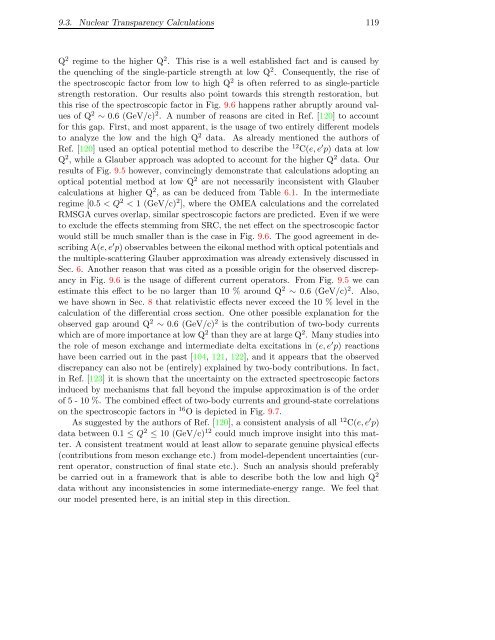Download Thesis in Pdf Format - Theoretical Nuclear Physics and ...
Download Thesis in Pdf Format - Theoretical Nuclear Physics and ...
Download Thesis in Pdf Format - Theoretical Nuclear Physics and ...
You also want an ePaper? Increase the reach of your titles
YUMPU automatically turns print PDFs into web optimized ePapers that Google loves.
9.3. <strong>Nuclear</strong> Transparency Calculations 119<br />
Q 2 regime to the higher Q 2 . This rise is a well established fact <strong>and</strong> is caused by<br />
the quench<strong>in</strong>g of the s<strong>in</strong>gle-particle strength at low Q 2 . Consequently, the rise of<br />
the spectroscopic factor from low to high Q 2 is often referred to as s<strong>in</strong>gle-particle<br />
strength restoration. Our results also po<strong>in</strong>t towards this strength restoration, but<br />
this rise of the spectroscopic factor <strong>in</strong> Fig. 9.6 happens rather abruptly around values<br />
of Q 2 ∼ 0.6 (GeV/c) 2 . A number of reasons are cited <strong>in</strong> Ref. [120] to account<br />
for this gap. First, <strong>and</strong> most apparent, is the usage of two entirely different models<br />
to analyze the low <strong>and</strong> the high Q 2 data. As already mentioned the authors of<br />
Ref. [120] used an optical potential method to describe the 12 C(e, e ′ p) data at low<br />
Q 2 , while a Glauber approach was adopted to account for the higher Q 2 data. Our<br />
results of Fig. 9.5 however, conv<strong>in</strong>c<strong>in</strong>gly demonstrate that calculations adopt<strong>in</strong>g an<br />
optical potential method at low Q 2 are not necessarily <strong>in</strong>consistent with Glauber<br />
calculations at higher Q 2 , as can be deduced from Table 6.1. In the <strong>in</strong>termediate<br />
regime [0.5 < Q 2 < 1 (GeV/c) 2 ], where the OMEA calculations <strong>and</strong> the correlated<br />
RMSGA curves overlap, similar spectroscopic factors are predicted. Even if we were<br />
to exclude the effects stemm<strong>in</strong>g from SRC, the net effect on the spectroscopic factor<br />
would still be much smaller than is the case <strong>in</strong> Fig. 9.6. The good agreement <strong>in</strong> describ<strong>in</strong>g<br />
A(e, e ′ p) observables between the eikonal method with optical potentials <strong>and</strong><br />
the multiple-scatter<strong>in</strong>g Glauber approximation was already extensively discussed <strong>in</strong><br />
Sec. 6. Another reason that was cited as a possible orig<strong>in</strong> for the observed discrepancy<br />
<strong>in</strong> Fig. 9.6 is the usage of different current operators. From Fig. 9.5 we can<br />
estimate this effect to be no larger than 10 % around Q 2 ∼ 0.6 (GeV/c) 2 . Also,<br />
we have shown <strong>in</strong> Sec. 8 that relativistic effects never exceed the 10 % level <strong>in</strong> the<br />
calculation of the differential cross section. One other possible explanation for the<br />
observed gap around Q 2 ∼ 0.6 (GeV/c) 2 is the contribution of two-body currents<br />
which are of more importance at low Q 2 than they are at large Q 2 . Many studies <strong>in</strong>to<br />
the role of meson exchange <strong>and</strong> <strong>in</strong>termediate delta excitations <strong>in</strong> (e, e ′ p) reactions<br />
have been carried out <strong>in</strong> the past [104, 121, 122], <strong>and</strong> it appears that the observed<br />
discrepancy can also not be (entirely) expla<strong>in</strong>ed by two-body contributions. In fact,<br />
<strong>in</strong> Ref. [123] it is shown that the uncerta<strong>in</strong>ty on the extracted spectroscopic factors<br />
<strong>in</strong>duced by mechanisms that fall beyond the impulse approximation is of the order<br />
of 5 - 10 %. The comb<strong>in</strong>ed effect of two-body currents <strong>and</strong> ground-state correlations<br />
on the spectroscopic factors <strong>in</strong> 16 O is depicted <strong>in</strong> Fig. 9.7.<br />
As suggested by the authors of Ref. [120], a consistent analysis of all 12 C(e, e ′ p)<br />
data between 0.1 ≤ Q 2 ≤ 10 (GeV/c) 12 could much improve <strong>in</strong>sight <strong>in</strong>to this matter.<br />
A consistent treatment would at least allow to separate genu<strong>in</strong>e physical effects<br />
(contributions from meson exchange etc.) from model-dependent uncerta<strong>in</strong>ties (current<br />
operator, construction of f<strong>in</strong>al state etc.). Such an analysis should preferably<br />
be carried out <strong>in</strong> a framework that is able to describe both the low <strong>and</strong> high Q 2<br />
data without any <strong>in</strong>consistencies <strong>in</strong> some <strong>in</strong>termediate-energy range. We feel that<br />
our model presented here, is an <strong>in</strong>itial step <strong>in</strong> this direction.















